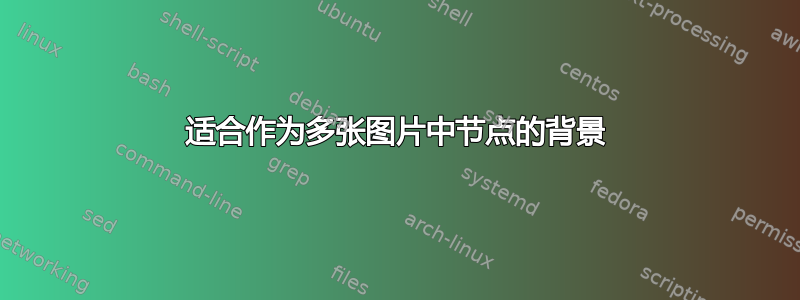
我使用 TikZ 图片来表示方程中的项,我想通过在它们后面绘制一个矩形来直观地对其中一些项进行分组。但每个项都是一个单独的图片,这意味着我不能只在背景层上绘制矩形。有没有办法让矩形出现在方程后面,尽管我事先不知道在哪里绘制矩形?
以下示例展示了我自己能做到的最好事情,即让矩形出现在等式前面。我编辑了该问题上一版本的示例,使其更加真实,因为它会影响一些建议解决方案的可用性。(抱歉!我的 MWE 一开始太小了。)

代码:
\documentclass[b3paper]{baposter}
\usepackage{tikz,amsmath}
\usetikzlibrary{fit}
\begin{document}
\begin{poster}{bgColorOne=blue!20!white,background=plain}{}{}{}{}
\begin{posterbox}[textborder=none,headerborder=none,span=3,boxColorOne=white]{title}
\begin{align}
x &=
\begin{tikzpicture}[remember picture]
\node[circle,fill=red,minimum width=1cm] {};
\end{tikzpicture}
+
\begin{tikzpicture}[remember picture]
\node[circle,fill=cyan,minimum width=1cm] (first node) {};
\end{tikzpicture}
\\
y &=
\begin{tikzpicture}[remember picture]
\node[circle,fill=red,minimum width=1cm] {};
\end{tikzpicture}
+
\begin{tikzpicture}[remember picture]
\node[circle,fill=cyan,minimum width=1cm] (second node) {};
\end{tikzpicture}
+
\begin{tikzpicture}[remember picture]
\node[circle,fill=green,minimum width=1cm] (third node) {};
\end{tikzpicture}
\end{align}
\begin{tikzpicture}[remember picture,overlay]
\node[draw=red,fill=yellow,fill opacity=0.8,fit=(first node) (second node) (third node),rectangle] {};
\end{tikzpicture}
\end{posterbox}
\end{poster}
\end{document}
这有点棘手,因为
- 我想要突出显示的图片在源中并不连续,并且
- 有一个现有的背景,我必须在上面画,所以这实际上是粘贴一张图片的问题之间文档的两个现有“层”。
答案1
一种可能性是使用安德鲁·史黛西的改进版本\tikzmark(参见他的回答tikzmark 在首次运行时会有不同的行为(并且标记位置尚不可用)); 在以下示例中,该\placemark命令负责放置标记;其第一个强制参数可用于选择当前边界框的锚点,第二个参数为标记命名。然后可以将名称用作宏的参数\DrawRect:
\documentclass{article}
\usepackage{amsmath}
\usepackage{tikz}
\usetikzlibrary{fit}
\makeatletter
\tikzset{%
remember picture with id/.style={%
remember picture,
overlay,
save picture id=#1,
},
save picture id/.code={%
\edef\pgf@temp{#1}%
\immediate\write\pgfutil@auxout{%
\noexpand\savepointas{\pgf@temp}{\pgfpictureid}}%
},
if picture id/.code args={#1#2#3}{%
\@ifundefined{save@pt@#1}{%
\pgfkeysalso{#3}%
}{
\pgfkeysalso{#2}%
}
}
}
\def\savepointas#1#2{%
\expandafter\gdef\csname save@pt@#1\endcsname{#2}%
}
\def\tmk@labeldef#1,#2\@nil{%
\def\tmk@label{#1}%
\def\tmk@def{#2}%
}
\tikzdeclarecoordinatesystem{pic}{%
\pgfutil@in@,{#1}%
\ifpgfutil@in@%
\tmk@labeldef#1\@nil
\else
\tmk@labeldef#1,(0pt,0pt)\@nil
\fi
\@ifundefined{save@pt@\tmk@label}{%
\tikz@scan@one@point\pgfutil@firstofone\tmk@def
}{%
\pgfsys@getposition{\csname save@pt@\tmk@label\endcsname}\save@orig@pic%
\pgfsys@getposition{\pgfpictureid}\save@this@pic%
\pgf@process{\pgfpointorigin\save@this@pic}%
\pgf@xa=\pgf@x
\pgf@ya=\pgf@y
\pgf@process{\pgfpointorigin\save@orig@pic}%
\advance\pgf@x by -\pgf@xa
\advance\pgf@y by -\pgf@ya
}%
}
\newcommand\tikzmark[2][]{%
\tikz[remember picture with id=#2] #1;}
\makeatother
\newcommand\placemark[2]{%
\node[inner sep=0pt,outer sep=0pt] at #1 {\tikzmark{#2}};
}
\newcommand\DrawRect[2]{%
\begin{tikzpicture}[overlay,remember picture]%
\node[draw=red,fill=yellow,fill opacity=0.8,fit=(pic cs:#1) (pic cs:#2),rectangle] {};
\end{tikzpicture}%
}
\begin{document}
\DrawRect{fnode}{snode}
\DrawRect{finode}{sinode}
\DrawRect{fiinode}{siinode}
\begin{equation}
x =
\begin{tikzpicture}[remember picture]
\node[circle,fill=red,minimum width=1cm] (first node) {};
\end{tikzpicture}
+
\begin{tikzpicture}[remember picture]
\node[circle,fill=cyan,minimum width=1cm] (first node) {};
\placemark{(current bounding box.north west)}{fnode}
\end{tikzpicture}
+
\begin{tikzpicture}[remember picture]
\node[circle,fill=green,minimum width=1cm] (second node) {};
\placemark{(current bounding box.south east)}{snode}
\end{tikzpicture}
\end{equation}
\begin{equation}
x =
\begin{tikzpicture}[remember picture]
\node[circle,fill=red,minimum width=1cm] (first node) {};
\placemark{(current bounding box.north west)}{finode}
\end{tikzpicture}
+
\begin{tikzpicture}[remember picture]
\node[circle,fill=cyan,minimum width=1cm] (first node) {};
\placemark{(current bounding box.south east)}{sinode}
\end{tikzpicture}
+
\begin{tikzpicture}[remember picture]
\node[circle,fill=green,minimum width=1cm] (second node) {};
\end{tikzpicture}
\end{equation}
\begin{align}
x &=
\begin{tikzpicture}[remember picture]
\node[circle,fill=red,minimum width=1cm] {};
\end{tikzpicture}
+
\begin{tikzpicture}[remember picture]
\node[circle,fill=cyan,minimum width=1cm] (first node) {};
\placemark{(current bounding box.north west)}{fiinode}
\end{tikzpicture}
\\
y &=
\begin{tikzpicture}[remember picture]
\node[circle,fill=red,minimum width=1cm] {};
\end{tikzpicture}
+
\begin{tikzpicture}[remember picture]
\node[circle,fill=cyan,minimum width=1cm] (second node) {};
\end{tikzpicture}
+
\begin{tikzpicture}[remember picture]
\node[circle,fill=green,minimum width=1cm] (third node) {};
\placemark{(current bounding box.south east)}{siinode}
\end{tikzpicture}
\end{align}
\end{document}

该代码需要运行三次。
答案2
可能有更优雅的“纯 TikZ”解决方案,但您可以使用该包将矩形推送到背景atbegshi:
\documentclass{article}
\usepackage{atbegshi}
\usepackage{tikz}
\usetikzlibrary{fit}
\begin{document}
\begin{equation}
x =
\begin{tikzpicture}[remember picture]
\node[circle,fill=cyan,minimum width=1cm] (first node) {};
\end{tikzpicture}
+
\begin{tikzpicture}[remember picture]
\node[circle,fill=green,minimum width=1cm] (second node) {};
\end{tikzpicture}
\end{equation}
\AtBeginShipoutNext{
\AtBeginShipoutUpperLeft{
\begin{tikzpicture}[remember picture,overlay]
\node[draw=red,fill=yellow,fill opacity=0.8,fit=(first node) (second node),rectangle] {};
\end{tikzpicture}
}
}
\end{document}
答案3
您可以随时使用hf-tikz(因此需要运行两次编译):
\documentclass[b3paper]{baposter}
\usepackage{amsmath}
\usepackage[customcolors,norndcorners]{hf-tikz}
\tikzset{hf color setting/.style={
set fill color=yellow,
set border color=red,
},
hf specifications no vert align/.style={
above left offset={-0.05cm,1.05cm},
below right offset={0.05cm,-0.1cm},
hf color setting,
},
}
\begin{document}
\begin{poster}{bgColorOne=blue!20!white,background=plain}{}{}{}{}
\begin{posterbox}[textborder=none,headerborder=none,span=3,boxColorOne=white]{title}
\begin{align}
x &=
\begin{tikzpicture}[remember picture]
\node[circle,fill=red,minimum width=1cm] {};
\end{tikzpicture}
+
\tikzmarkin[hf specifications no vert align]{a}
\begin{tikzpicture}[remember picture]
\node[circle,fill=cyan,minimum width=1cm] (first node) {};
\end{tikzpicture}
\\
y &=
\begin{tikzpicture}[remember picture]
\node[circle,fill=red,minimum width=1cm] {};
\end{tikzpicture}
+
\begin{tikzpicture}[remember picture]
\node[circle,fill=cyan,minimum width=1cm] (second node) {};
\end{tikzpicture}
+
\begin{tikzpicture}[remember picture]
\node[circle,fill=green,minimum width=1cm] (third node) {};
\end{tikzpicture}
\tikzmarkend{a}
\end{align}
\end{posterbox}
\end{poster}
\end{document}
结果:

当然这需要baposter.cls编译。
第一个版本
\documentclass{article}
\usepackage[customcolors,norndcorners]{hf-tikz}
\tikzset{hf color setting/.style={
set fill color=yellow,
set border color=red,
},
hf specifications vert align/.style={
above left offset={-0.05cm,0.75cm},
below right offset={0.05cm,-0.55cm},
hf color setting,
},
hf specifications no vert align/.style={
above left offset={-0.05cm,1.05cm},
below right offset={0.05cm,-0.1cm},
hf color setting,
},
}
% vertical alignment within math environments see:
% http://tex.stackexchange.com/questions/59658/use-of-tikzpicture-matrix-in-align-or-gather-environment/59660#comment126261_59660
\def\vertmathalign{-\the\dimexpr\fontdimen22\textfont2\relax}
\begin{document}
With circle vertical alignment:
\begin{equation}
x =
\begin{tikzpicture}[baseline=\vertmathalign,remember picture]
\node[circle,fill=red,minimum width=1cm] (first node) {};
\end{tikzpicture}
+
\tikzmarkin[hf specifications vert align]{a}
\begin{tikzpicture}[baseline=\vertmathalign,remember picture]
\node[circle,fill=cyan,minimum width=1cm] (first node) {};
\end{tikzpicture}
+
\begin{tikzpicture}[baseline=\vertmathalign,remember picture]
\node[circle,fill=green,minimum width=1cm] (second node) {};
\end{tikzpicture}
\tikzmarkend{a}
\end{equation}
Without
\begin{equation}
x =
\begin{tikzpicture}[remember picture]
\node[circle,fill=red,minimum width=1cm] (first node) {};
\end{tikzpicture}
+
\tikzmarkin[hf specifications no vert align]{b}
\begin{tikzpicture}[remember picture]
\node[circle,fill=cyan,minimum width=1cm] (first node) {};
\end{tikzpicture}
+
\begin{tikzpicture}[remember picture]
\node[circle,fill=green,minimum width=1cm] (second node) {};
\end{tikzpicture}
\tikzmarkend{b}
\end{equation}
\end{document}
我区分了圆圈与公式正确对齐的情况和不对齐的情况;结果是:



